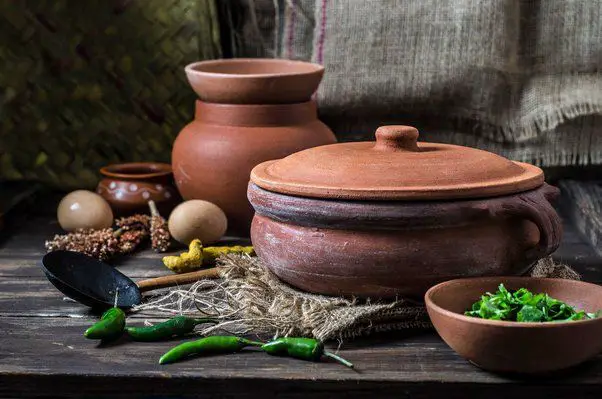What Are Three Examples Of Utensils Made With Clay?
Utensils are objects used in the preparation, serving or eating of food. Clay has been used to make utensils for thousands of years due to its durability, availability, and ability to be shaped. Before metal and plastic utensils became common, clay was one of the main materials used for making utensils around the world.
Clay utensils have remained popular over the centuries for several reasons. The porous nature of clay allows it to gradually absorb small amounts of liquids and oils, which can enhance the flavor of foods. Clay also has natural non-stick properties which make it ideal for cooking. Additionally, clay utensils are attractive and come in a wide variety of styles and designs.
The purpose of clay utensils is to hold, serve, or cook food in a functional and aesthetically pleasing way. Clay can be formed into plates, bowls, cups, pots, pans, and various specialized utensils based on its versatility as a material. Clay utensils provide a natural, traditional way of preparing and eating meals.
Clay Pots
Clay pots are one of the oldest and most ubiquitous cooking vessels, used for thousands of years across many cultures. Their unique properties make them ideal for cooking:
Clay retains heat remarkably well. Once heated up, clay pots maintain a steady temperature for a long time. This allows food to cook slowly and evenly without scorching.
The clay material also distributes heat gently and uniformly. There are no hot spots like in metal pots. Food cooks through without burning on the bottom.
Clay is a natural non-stick surface. Many clay pot dishes involve gentle simmering or stewing for hours, with the food releasing from the pot intact.
Clay pot cooking often enhances the flavor and texture of food. As clay permeates, it absorbs excess moisture while concentrating flavors.
With their low-and-slow cooking abilities, clay pot dishes like stews, rice, beans, curries, and more end up meltingly tender and full of flavor.
Clay Bowls
Clay bowls are one of the most common and versatile types of clay utensils. They have been used for thousands of years to serve both solid foods and liquids. Clay bowls are formed into a round, open-topped shape which is ideal for holding and serving a variety of contents.
One of the main uses of clay bowls is for serving food. Their durable construction allows them to hold both solid foods like vegetables, rice, pasta, or bread as well as liquids like soup, stew, or curry. The rounded open shape makes it easy to scoop out contents with a spoon or ladle. Clay bowls can be used to serve individual portions or family-style meals at the table.
In addition to serving food, clay bowls also work well for holding liquids on their own. Their solid sides prevent spilling, allowing liquids like water, milk, tea, or broth to be carried or drunk directly from the bowl. This makes clay bowls useful not just for serving but also for drinking and storage purposes.
Clay bowls have remained popular over time thanks to their durable and attractive nature. Clay is an incredibly strong material that can withstand regular daily use without cracking or breaking. At the same time, clay bowls can be decorated with beautiful glazes, patterns, or designs that make them decorative statement pieces for any table.
Clay Plates
Clay plates are one of the most common types of clay utensils used for serving food. They come in a wide variety of sizes and shapes depending on their intended use. Small clay plates around 6 inches in diameter often serve as appetizer plates or saucers. Medium sized plates around 9 inches work well for individual dinner plates. Large platters around 12 inches or more are ideal for serving main courses family-style. Clay plates can be glazed or unglazed, decorated with designs, left plain, or made in bright colors. Their absorbent material helps to soak up grease and condensation when serving hot foods. Sturdy clay plates hold up well to daily use. With proper care, these traditional clay utensils can last for many years.
Clay Cups
Clay cups are a type of utensil made from clay that are commonly used for drinking. They come in a variety of styles such as mugs, tankards, goblets, and chalices. Clay cups have been used throughout history for consuming beverages like water, wine, tea, coffee, and more.
One of the benefits of drinking from clay cups is that the porous material can help cool down hot liquids faster than glass or metal. The clay also imparts a subtle flavor to the liquid. Clay cups are sturdy, durable, and often have an artisanal rustic aesthetic.
Clay cups can be customized with engravings, painted designs, or other embellishments. They are a popular souvenir item across many cultures. In terms of functionality, the handle offers a comfortable and secure grip, while the open container shape makes it easy to drink from.
Overall, clay cups are versatile utensils well-suited for casual and formal drinking. Their earthy material provides a natural feel, retains temperature well, and brings out nuances in the taste of beverages.
Clay Spoons
Clay spoons are one of the most common types of utensils made from clay. They have been used for eating and serving food for thousands of years across many cultures.
Clay spoons can be molded into simple or intricate shapes and designs. The clay allows artisans to form decorative patterns along the handle and bowl of the spoon. Geometric shapes, floral motifs, and abstract designs are often seen on clay spoons to make them aesthetically pleasing.
The fired clay makes the spoons durable enough for daily use. Though not as smooth or refined as metal cutlery, clay spoons provide a natural, rustic feel. Many handmade clay spoons are signed or stamped by their creator, making them wonderful works of art.
Clay spoon making is still practiced around the world today, especially among pottery artisans. Unique clay spoons can make excellent kitchen decor or housewarming gifts.
Clay Ladles
Clay ladles have been used for serving liquids and soups for centuries across many cultures. They often have an oval or round bowl with a long handle to keep hands away from hot liquids. The length of the handle provides leverage for dipping and pouring.
Clay is an ideal material for ladles because it holds heat well. This keeps liquids warmer compared to metal ladles. The porous nature of clay also allows some cooling evaporation to take place through the material, preventing burns. Clay ladles can be made into various shapes, sizes and designs.
Common features of clay ladles include:
- A long handle, usually 6 inches or longer.
- A bowl capacity between 4-12 ounces.
- A curved or hooked shape to the end of the handle for easy hanging storage.
- Decorated with glazes, colors, or designs.
Clay ladles have remained essential kitchen tools throughout history thanks to their versatility, functionality and aesthetic potential. They continue to be popular choices for serving and eating soups and stews.
Teapots
Clay teapots have been a popular method of brewing and serving tea for centuries in many cultures around the world. The porous nature of clay allows the teapot to absorb excess heat from the boiling water inside, helping to temper and enhance the flavor of the tea leaves during steeping. The warmth retained in the clay also helps keep the brewed tea piping hot for the duration of the tea service.
High quality clay holds heat very evenly and does not impart any flavors or chemicals to the tea. Yixing teapots made from Chinese “purple clay” are renowned for bringing out the best flavors from teas like oolong, black, and pu-erh. In Japan, kyūsu teapots crafted from hohin clay are designed specifically for steeping green tea.
For tea enthusiasts, clay teapots are treasured not just for their functionality but also as beautiful works of art glazed in myriad colors and patterns. The tiny pores on the interior surface of a seasoned clay teapot will gradually stain over many uses, creating a lovely patina that adds to the charm and character of the vessel.
Other Clay Utensils
In addition to pots, bowls, plates, cups, spoons, ladles, and teapots, clay has been used to create many other types of utensils across cultures worldwide. Some examples include:
Mortar and Pestle
Mortar and pestles made from clay have been used for thousands of years to crush spices and herbs. The mortar is a bowl, while the pestle is a blunt club-shaped object. The spice or herb is placed in the mortar and ground manually with the pestle.
Butter Dishes
Clay butter dishes have been common kitchen items for centuries in many parts of the world. The lidded dish keeps butter cool and prevents it from spoiling as quickly. Butter dishes are still popular today, often made from glazed ceramic.
Regional Clay Utensils
Many cultures have developed unique clay utensils attuned to their cuisine, lifestyle, values and local materials. For example, in parts of Asia and Africa, clay steamers have been essential for cooking rice and vegetables. In the Americas, clay griddles and comales are traditional for making tortillas. Unique clay pots for specialized stews and braises can be found in diverse food cultures globally.
Conclusion
In summary, there are many types of utensils that can be made from clay. Some examples we discussed include clay pots, bowls, plates, cups, spoons, ladles, and teapots. Clay utensils provide a number of benefits over other materials:
- Clay is a natural material that does not leach chemicals or metals into foods. This makes clay utensils safe and non-toxic.
- Clay has natural non-stick properties which allow cooking and serving without the need for oils or coatings.
- Clay retains heat well, keeping foods and liquids warmer longer.
- Clay utensils are durable and long-lasting yet still inexpensive to produce.
- The porous nature of clay allows steam and moisture to pass through, which can enhance cooking.
- Clay utensils bring an organic, handmade feel and aesthetic to any kitchen or table.
With their versatility, safety, and artisanal appeal, it’s easy to see why clay utensils remain popular choices for cooks and diners alike.



